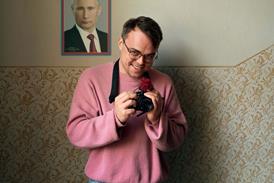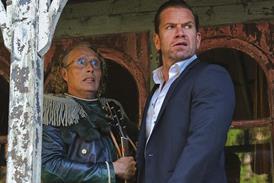CINEMATOGRAPHY
Dion Beebe, MemoirsOf A Geisha
Dion Beebe, who earned an Oscar nomination in 2003 forRob Marshall's Chicago, was determinedto capture the reality of 1930s Japan in Marshall's follow-up MemoirsOf A Geisha.
Beebe, Marshall and their team travelled to Japan on arecce, but eventually decided to replicate a geisha district on a giant set inVentura Country outside Los Angeles.
'We used lanterns as the primary light source forthe film as a way of evoking the mystery of the place,' Beebe says.
'We created a patina of rich, warm yellow tones torecreate this aged world in Kyoto. I wanted to show the passage of time throughthe changing seasons, which reflected Sayuri's emergence from adolescence intowomanhood.
Even within the central house, the seasonal changesaffected not only the interior design but the way I lit it.
'The incredible set presented a major challenge interms of shooting Kyoto because you're in California where the sun shines 300 daysa year,' Beebe says. 'I had to diffuse the lighting and we built amassive retractable silk screen over the entire town to control the light andhelp us with those seasonal changes.'
Robert Elswit, GoodNight, And Good Luck and Syriana
'It's the best year I've ever had,' sayscinematographer Robert Elswit, whose eclectic filmography includes Heist,Bounce, The River Wild, Waterland and PaulThomas Anderson's features.
Elswit brought his talents to both Good Night, AndGood Luck, the black-and-white Edward RMurrow story directed by George Clooney, and Syriana, the war-and-oil drama directed by Trafficscreenwriter Stephen Gaghan.
The films could hardly look more different from eachother. 'George [Clooney] didn't want to plot out too much. There were nostoryboards, no shot list, nothing like that. He wanted it to develop as theactors worked.'
Although the actual 1950s-era CBS sites were in threedifferent Manhattan locations, Good Night, And Good Luck moves them into one which was shot on a set that wasone contiguous space. 'It was a brilliant thing,' Elswit says.
'One big set - the locations all spilled into eachother.'
Elswit says the black and white shooting, which evokesthe era in which the film is set, was lit differently for different scenes -1930s noir-style for the newsroom; 'modern and flatter' for theoffice spaces and more theatrically for the studio in which Murrow broadcast.
'There's something wonderful about black andwhite,' he says, 'where you're not distracted by colour, and thecostumes fall away and you're really able to look at the physiognomy of theface.'
For Syriana, amulti-character, multi-plotted story about terrorism, the CIA and thestranglehold of the oil industry on world politics, Gaghan wanted quite theopposite of what was accomplished with the Steven Soderbergh-directed Traffic - in which all the locations were given a verydistinctive look.
'It was rainy while we were in Washington, andGeneva, too,' Elswit explains, 'and sunny and dry in the Middle East.But Stephen [Gaghan] wanted, thematically, the sense that all these places wereconnected.' And accomplishing that, he says, meant 'not imposing avisual style'. Not an easy thing for a cinematographer, one imagines,although Elswit is certainly not complaining.
Janusz Kaminski, WarOf The Worlds and Munich
'The challenge was to create a movie that would be abig Hollywood production with a little bit of art in it,' says two-timeOscar-winning cinematographer Janusz Kaminski of his work on War Of TheWorlds.
'I love how dark this film was, which is something asummer audience doesn't expect. The movie starts with a normal look and isn'tparticularly challenging visually. As the horror unfolds and you get into thebasement, you get lots of shadows and I introduce the blue and red lights ofthe tripods.'
Kaminski first worked with Steven Spielberg on the TVmovie Class Of '61, after the directornoticed his work on Diane Keaton's 1989 TV movie Wildflower. Since then he has won Academy Awards for Schindler's Listin 1994 and Saving Private Ryanin 1999.
'I tried to create believability in both thosefilms, and again here I wanted to create a world that was as realistic aspossible because the story is so far-fetched,' Kaminski says.
Physical production was tough, he says. 'Stevendoesn't normally use storyboards but he did here. After he pre-visualised thepicture, we shot around the US for 76 days with hundreds of extras and lots ofequipment.
Working with Steven you have to be quick: we wereaveraging 20 set-ups a day and it's so fast it's like television. If it was aperformance-driven picture he would have taken more time, but this was actionso it was fast.'
Kaminski recently shot Munich and is under strict ordersfrom Spielberg not to discuss details until the December 23 release.
'It was really interesting to work on a Europeanmovie like this. It takes place in Europe and Israel and Greece and Cyprus andwe shot primarily in Malta and Budapest. It was a very international crew andit's a fantastic film.'
Roger Deakins, Jarhead
With more than 50 features and five Oscar nominations tohis credit, including three for his work with the Coen Brothers - The ManWho Wasn't There, O Brother, Where Art Thou' andFargo - Roger Deakins seems duefor the supreme gong.
The picture in question this year is Sam Mendes' Gulf Warsaga Jarhead, starring Jake Gyllenhaalas the eponymous US Marine adrift in the searing Middle Eastern desert.
Here is the first surprise: the production team did nottravel far from Los Angeles to simulate the heat and light of Operation DesertStorm. Most of the location material was shot in El Centro, in southernCalifornia, with a surprising amount of stage work in Hollywood. Deakins' remitwas straight-forward.
'Sam wanted this feeling of nothingness. These guysare flown into this very real but surreal landscape.'
He is particularly pleased with a night sequence againstthe backdrop of the conflict's most memorable image: the towering infernos ofoil rigs. Shooting on a soundstage against a black cyclorama, he rigged narrowlighting towers with flicker generators and then shot the sequence withhandheld cameras.
Effects house ILM then took out the light towers andreplaced them with CGI flames. The effect is uncanny. As he puts it, 'Thelight was blooming.'
A prize would be nice but, as he points out, some of hisbest work has gone unnoticed.
He singles out Michael Radford's 1984, with its drained greyness juxtaposed with the deepsaturation of Winston Smith's reveries. He thinks they should give out awardsbased on budget. 'So many films are stunning for what they achieve with solittle,' he says.
OTHER CONTENDERS
Emanuel Luzbecki,The New World
Chris Doyle, TheWhite Countess
Rodrigo Prieto, BrokebackMountain
Andrew Lesnie, KingKong
Cesar Charlone, TheConstant Gardener
Donald McAlpine, TheChronicles Of Narnia: The Lion, The Witch And The Wardrobe
John Mathieson, KingdomOf Heaven
Chris Menges, TheThree Burials Of Melquiades Estrada
Adam Kimmel, Capote
Robert Rodriguez,Sin City
Salvatore Totino,Cinderella Man
Andrew Dunn, MrsHenderson Presents
Oliver Stapleton,Casanova
James Muro, Crash
EDITING
Mike Hill and Dan Hanley Cinderella Man
Over their 23-year collaboration with director RonHoward, Mike Hill and Dan Hanley have edited films in a range of genres, fromthe romantic comedy of Splash, throughthe fantasy of Willow to the dramatic adventure of Apollo 13, for which they both received Oscars in 1996.
On Howard's Cinderella Man, Hill and Hanley had to handle different kinds of action within asingle film.
The movie's big boxing scenes, shot with multiple camerasand from multiple points of view, were the most obvious test of the duo'sediting skills. To intensify the action, Hill and Hanley used techniques suchas freezing the action for two or three frames to highlight an individualpunch.
Mostly, though, the ring sequences demanded selectivity.'Just getting through the sheer volume of film [shot] was achallenge,' says Hanley, 'They did a lot of great fight choreography,so the main challenge was to find the best of the best.'
The film's dramatic scenes, when hero Jim Braddock isseen struggling to keep his family together, were just as much of a challenge,both editors confirm. 'For me, the dialogue scenes in any film are muchmore interesting,' Hill asserts. 'I don't think people realise howmuch goes into the editing of performances. An editor's obligation is to theactor, to do him justice.'
OTHER CONTENDERS
Tim Squyres, Syriana
Pietro Scalia, MemoirsOf A Geisha
Geraldine Peroni and Dylan Tichenor, Brokeback Mountain
Jamie Selkirk, KingKong
Claire Simpson, TheConstant Gardener
Lee Smith, BatmanBegins
Sim Evan-Jones and Jim May, The Chronicles Of Narnia: The Lion, The Witch & The Wardrobe
Stephen Mirrione,Good Night, And Good Luck
Hughes Winborne, Crash
Michael Kahn, Munichand War Of The Worlds
Walter Murch,Jarhead
Christopher Tellefsen, Capote
Richard Chew, Hank Corwin and Saar Klein, The New World
Robert Rodriguez,Sin City
Ronald Sanders, AHistory Of Violence
Michael McCusker,Walk The Line
Dody Dorn, KingdomOf Heaven
Richard Pearson, Rent
Paul Tothill, Pride& Prejudice
VISUAL EFFECTS
John Letteri KingKong
The big ape was the big challenge for John Letteri,visual effects supervisor on King Kong.
In Peter Jackson's new version of the story forUniversal, Kong is 'an animal wehave to read as an animal', says Letteri, 'but we also have tounderstand what he's thinking and feeling in his relationships to the othercharacters.
That's been the toughest challenge - to walk the linebetween making him look believable as an animal and conveying a character thatcan perform and that you can connect with.'
To create the all-CG Kong, Letteri, who won Oscars for his effects work on the second and thirdinstalments of Jackson's The Lord Of The Rings trilogy, drew on his experience with the trilogy'sdigital character, Gollum.
Letteri and his team at Jackson's Weta Digital inWellington, New Zealand, began - as they did for the Rings character - by doingbodily motion-capture work with Andy Serkis, the actor who modelled for, andwas the voice of, Gollum.
This time the team experimented with facial-motioncapture, using Serkis' expressions as a basis for Kong's.
The motion-capture system, Letteri explains, was'taught to 'read' Andy's expressions. Then we created a corresponding setof expressions for Kong. The system would read anger or fear or even melancholy- any beat Andy was playing would be interpreted for Kong. We call it'gorillification''.
Dean Wright TheChronicles Of Narnia: The Lion, The Witch And The Wardrobe
Dean Wright took on a major task with his first film as avisual effects supervisor.
Narnia containsalmost 1,700 special-effects shots, more than 1,000 of them involving fullcharacter animation.
Wright, whose previous credits - most of them as visualeffects producer or executive producer - include Reign Of Fire and the last twoparts of the Lord Of The Rings trilogy,says the project kept him busy on several fronts.
One task, he explains, was working with director AndrewAdamson on 'making sure we got whatever performance was needed on set fromthe kids'. The four young stars of Walden Media's adaptation of CS Lewis'classic fantasy novel had to learn quickly how to act in front of green screensand interact with CG characters.
Wright also had to coax the best possible performancefrom animators who were handling 'a tremendous workload', on a storyfeaturing dozens of different fantasy creatures.
Most important was making sure the CG characters' actingmatched that of their human counterparts. 'The kids and Tilda [Swinton,who plays the evil White Witch] give incredibly strong performances,'Wright says. 'The CG characters had to stand up to that and match theemotional depth. A huge effort was put into giving the animators facial controlso the characters could give nuanced performances.'
He cites one scene in which Aslan the Lion (voiced byLiam Neeson) does not speak but had to be seen experiencing a range ofemotions: 'All the emotions had to be conveyed through the expressions inhis eyes, his mouth, his body language and his gestures.'
Working through the long New Zealand shoot and then thepost-production period felt like 'a marathon sprint', says Wright.'But you don't mind the long hours and hard work when you're creatingsomething you think has the chance to be a very special project.' JohnHazelton
OTHER CONTENDERS
Star Wars: Episode III
- RevengeOf The Sith
Batman Begins
Sin City
War Of The Worlds
Harry Potter And The
Goblet OfFire
Fantastic Four
The Island
















![[Clockwise from top left]: Paul Thomas Anderson, Chloe Zhao, Ryan Coogler, Park Chan-wook](https://d1nslcd7m2225b.cloudfront.net/Pictures/274x183/9/0/0/1467900_writerdirectors_192733.jpg)

No comments yet